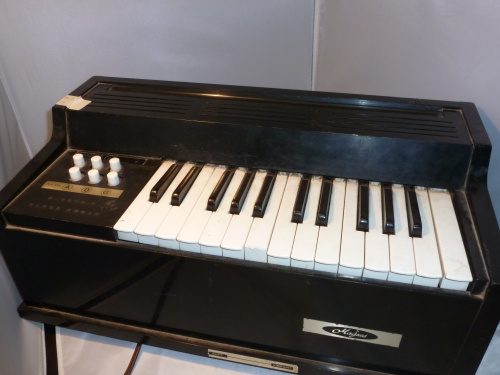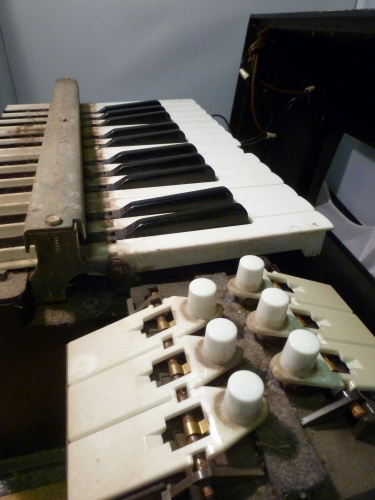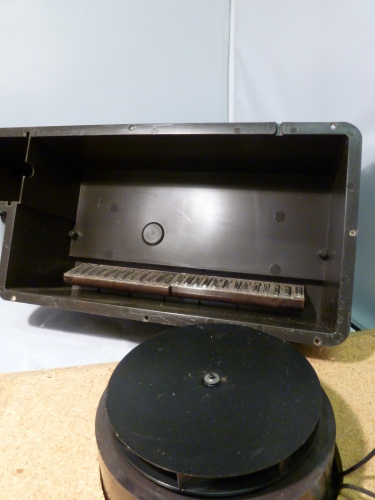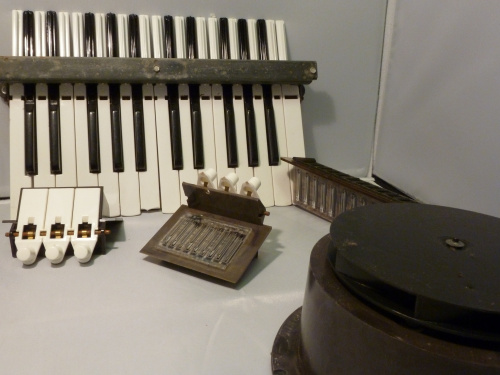Many moons ago, I came across a Magnus Electric Chord Organ at a garage sale. I figured even if I couldn't ~~play it~~ ~~annoy my neighbors with it~~ hack the electronics, it could be gutted and used as a project enclosure. With festival season quickly approaching, it seems the time has come to begin brainstorming its second life.
The model 300 from Magnus Harmonica Corporation
The bottom is stamped with the following label, claiming it is a Magnus Organ Corporation Model 300, with ratings that appear to be 120V, 50 CYC A.C., 42 Watts, 0.375 Amps. A quick interwebs search however did not lead to much in the way of a datasheet.
With an electronic keyboard-like appearance, I assumed that the inner workings of this instrument would be filled with electronic wonder. Turns out I was very, very wrong (let this be a lesson about how reading the manual beforehand can save you disappointment). The fan on the unit worked when switched on, but alas, I was unable to generate any sound from any of the keys.
The first thing I discovered after opening it up was the sheer amount of dust collected internally, thanks to the bottom fan. For anyone who has ever cleaned a computer tower, this won't come as a surprise.
Holy dust Batman!
My surprise really hit a head when I removed the secondary cover (the structure supporting the keys), and found that the inside was empty. The only electronic part visible is the fan at the base.
The only electric part, the motor, and the inside of the secondary case.
Thanks to Liz from tech support (they are always there to answer your questions!), I learned that the plastic bits are the reeds, which give each key its tuning. As each key is played, this opens a path for the air to flow, vibrating against the reed, and creating a note.
Here you can see many of the plastic reeds that create the different notes.
With a good cleaning of all the parts, the mechanical functionality of the unit seems to in fine working order. I wanted to verify that it was just the dust and seal failures that initially caused the organ to malfunction, as the fan turns on, runs consistently, and turns off without issue. Using one of our Non-invasive current sensors, a quick check shows the motor is running in spec, at about 0.4 Amps.
With it all cleaned, I reassembled the insides and sealed the edges to prevent leaks on the airflow. It works great!
Look at those clean (plastic) ivories.
Because I originally expected to have a lot of electronics to deal with on the guts of this thing, I was expecting to be pretty limited on the type of hacking I could do. However, now seeing a) how much space there is internally, and b) understanding that I just need to keep the airflow from the fan going properly, I'm overwhelmed with ideas of what I could add. Perhaps a capacitive sensor breakout that will trigger lights to blink as the keys are played? A pressure sensor on a few keys that will determine motor speeds depending on the intensity of the user playing it? Hook it up to the internet, throw in a few solenoids and create my very own player organ? The possibilities are endless!
If you've ever hacked an organ, or any other wind instrument (accordion anyone?), we'd love to hear what mods you made. Leave us a comment below!











Replace fan with propane. The rest writes itself.
That's an ending I'm not sure I want to see, or miss, I really can't decide. :)
I just finished rebuilding this player piano as a MIDI instrument. With help from parts I got on SparkFun. :)
https://medium.com/@hackmancoltaire/adventures-in-piano-building-c3fe5fa0b56b
Yes. Very nicely done. Great project and great documentation.
Thanks! :D
I'll be fixing the PCB design and then making it public for people to order from OSH Park sometime before May, where I hope to have it ready for the Bay Area Maker Faire.
The recursive cyborg instrument: sample each note, and put them on an SD card. Then we can gut the organ, adding microswitches under each key, and use them with a Wav trigger, replacing the reeds with silicon.
That might be my favorite over-engineered idea, second to this.
I remember in the '70s, wanting one of those, but never getting it.. Wow.. who knew it was so low tech.. basically a cheap accordion with an electric fan instead of bellows...
That thing is begging for a MIDI-OUT plug.. :-)
I dig that idea :) You can find them for sale all over eBay and various auction houses if you still want one ;) . Did find a lot of those while looking for a datasheet.
This was the same instrument I first learned how to play piano on. Same key was chipped in fact...
Maybe it was your old instrument?
Here's a photo of the the wooden key. I'm proud. https://www.dropbox.com/s/nzxsg77x08eytsx/2020-04-06%2015.51.02.jpg?dl=0
Hi! I'm fixing one of these up. Just carved a new key out of wood! But the motor is so noisy! Do you think there's a source for quieter fan or motor parts?
Here's a photo of the the wooden key. I'm proud. https://www.dropbox.com/s/nzxsg77x08eytsx/2020-04-06%2015.51.02.jpg?dl=0
what type of material was used for the hardend seal?
Resealing the instrument back together? When I originally got it, it was just sealed using electrical tape. Epoxy would probably work well, or hot glue.
Edit: My guess though is that there's probably an official material to use. I'm guessing a local instrument shop may be able to provide better guidance.
Hey Toni,
I'm trying to fix up a model 668 and am searching for parts.
Do you still have a contact for the tech support you mentioned in your post?
Thanks!
Sadly, she no longer works here at SparkFun. That being said, it looks like there may be a few model 668s for sale specifically for parting out - maybe one of those will work for you?
Hi there I've been gifted just such an instrument a Magnus 399 and wanted to combine it with my other keyboards, only to find it's about a quarter tone flat. Is it possibly to tune it somehow?
Thanx for yer time Rob
Hey Rob - I've never tried to tune it myself, but from a quick search, it looks like you may need to file the reeds? Check out this link.
Just a thought, but if you go throwing a bunch of stuff in that big airspace and mounting it to the walls and such, you are probably going to wreak havoc with your acoustics! I'm not too familiar with how they are made, so it may be a non-issue, but if it uses that airspace/chamber walls for resonance, pretty much guarantees problems if you put stuff in it. Easy to test I guess, stick a foam/wood block in there and play it :)
Good luck!
Oh, ya know, that's a really good point. I was thinking most of the electronics would be small, but if I start messing with the power supply....hmm.
BACK TO THE DRAWING BOARD!
HA! Found one of these at the thrift store recently and did an almost exact replay of this! The previous owner had made some badly attempted repairs like doubling up the rubber seal and reattaching the chord-key panel with a roofing nail. Pulled the extra seal and a cats-worth of hair out and hooray fifteen dollar accordian/harmonica piano. Really want to make it DC instead of AC. Could probably fit a battery/charger pack in that massive airspace inside.
I've never thought of hacking it (oddly), but I do have one of these chord organs. It's fun to play completely dissonant notes and make terrible noise.
If you add a MIDI-OUT, MIDI-IN seems like an obvious next step. There's plenty of room for two octaves' worth of servos.
I actually had one of those when I was a kid...about 40 years ago.